ATMC ACC211 Task 2 2018: Investment Analysis of SSHA Model
VerifiedAdded on 2023/06/11
|7
|995
|408
Report
AI Summary
This report evaluates the profitability of a new SSHA (Smart Speaker and Home Assistant) model using various investment analysis techniques, including the non-discounted payback period, profitability index (PI), internal rate of return (IRR), and net present value (NPV). The analysis reveals a non-discounted payback period of 2.14 years and a PI of 1.65. The IRR is calculated to be 19.77%, and the NPV is $30,548,881.43, indicating a potentially profitable investment. Sensitivity analysis is conducted for both price and quantity changes, showing that the NPV is highly sensitive to changes in selling price and moderately sensitive to changes in selling quantity. The report concludes that Booli Enterprise should proceed with the production of the new SSHA model due to the positive NPV and recommends including potential losses from other products in the cost of investment analysis.

Running head: BUSINESS FINANCE
Business finance
Name of the student
Name of the university
Student ID
Author note
Business finance
Name of the student
Name of the university
Student ID
Author note
Paraphrase This Document
Need a fresh take? Get an instant paraphrase of this document with our AI Paraphraser
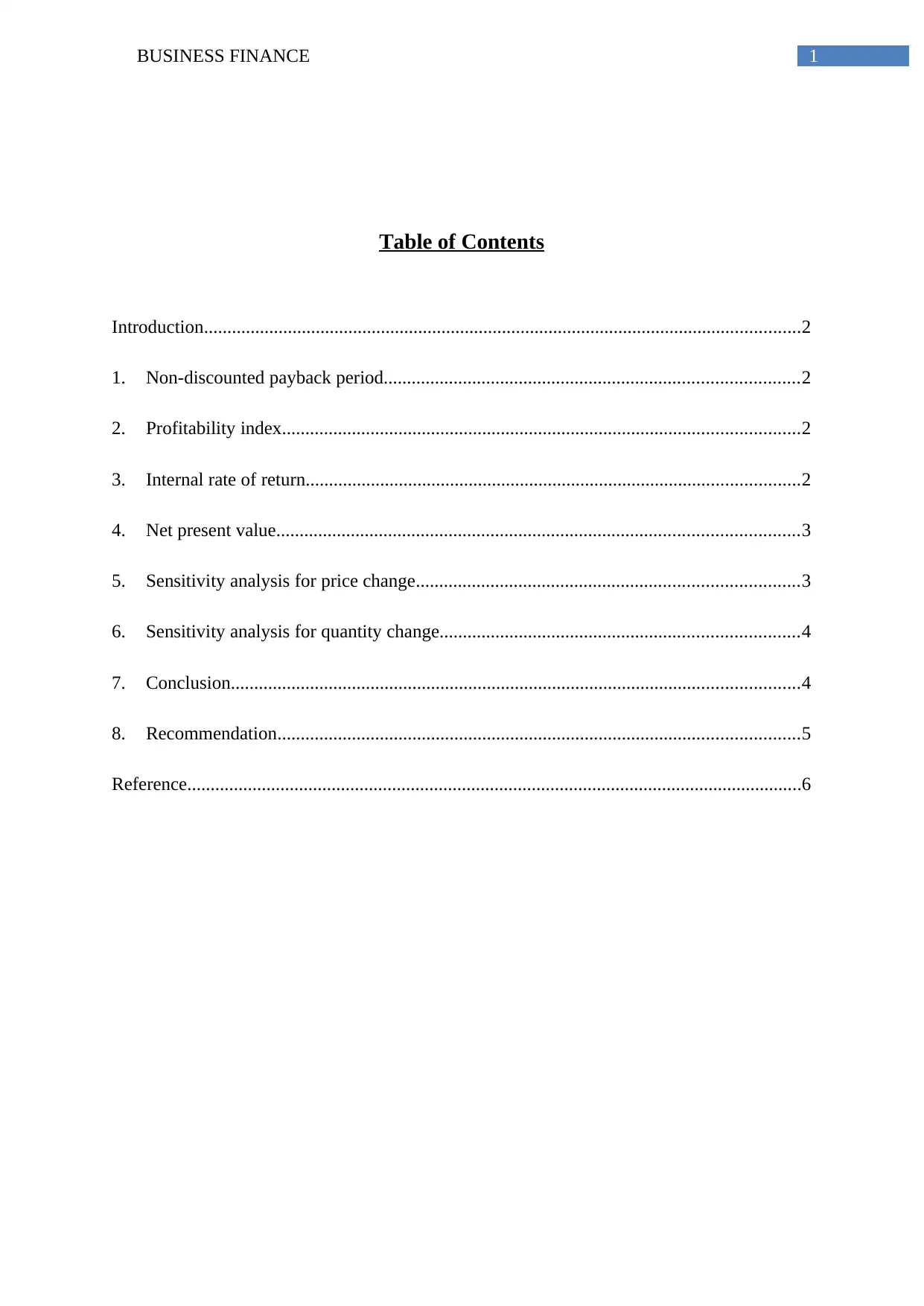
1BUSINESS FINANCE
Table of Contents
Introduction................................................................................................................................2
1. Non-discounted payback period.........................................................................................2
2. Profitability index...............................................................................................................2
3. Internal rate of return..........................................................................................................2
4. Net present value................................................................................................................3
5. Sensitivity analysis for price change..................................................................................3
6. Sensitivity analysis for quantity change.............................................................................4
7. Conclusion..........................................................................................................................4
8. Recommendation................................................................................................................5
Reference....................................................................................................................................6
Table of Contents
Introduction................................................................................................................................2
1. Non-discounted payback period.........................................................................................2
2. Profitability index...............................................................................................................2
3. Internal rate of return..........................................................................................................2
4. Net present value................................................................................................................3
5. Sensitivity analysis for price change..................................................................................3
6. Sensitivity analysis for quantity change.............................................................................4
7. Conclusion..........................................................................................................................4
8. Recommendation................................................................................................................5
Reference....................................................................................................................................6
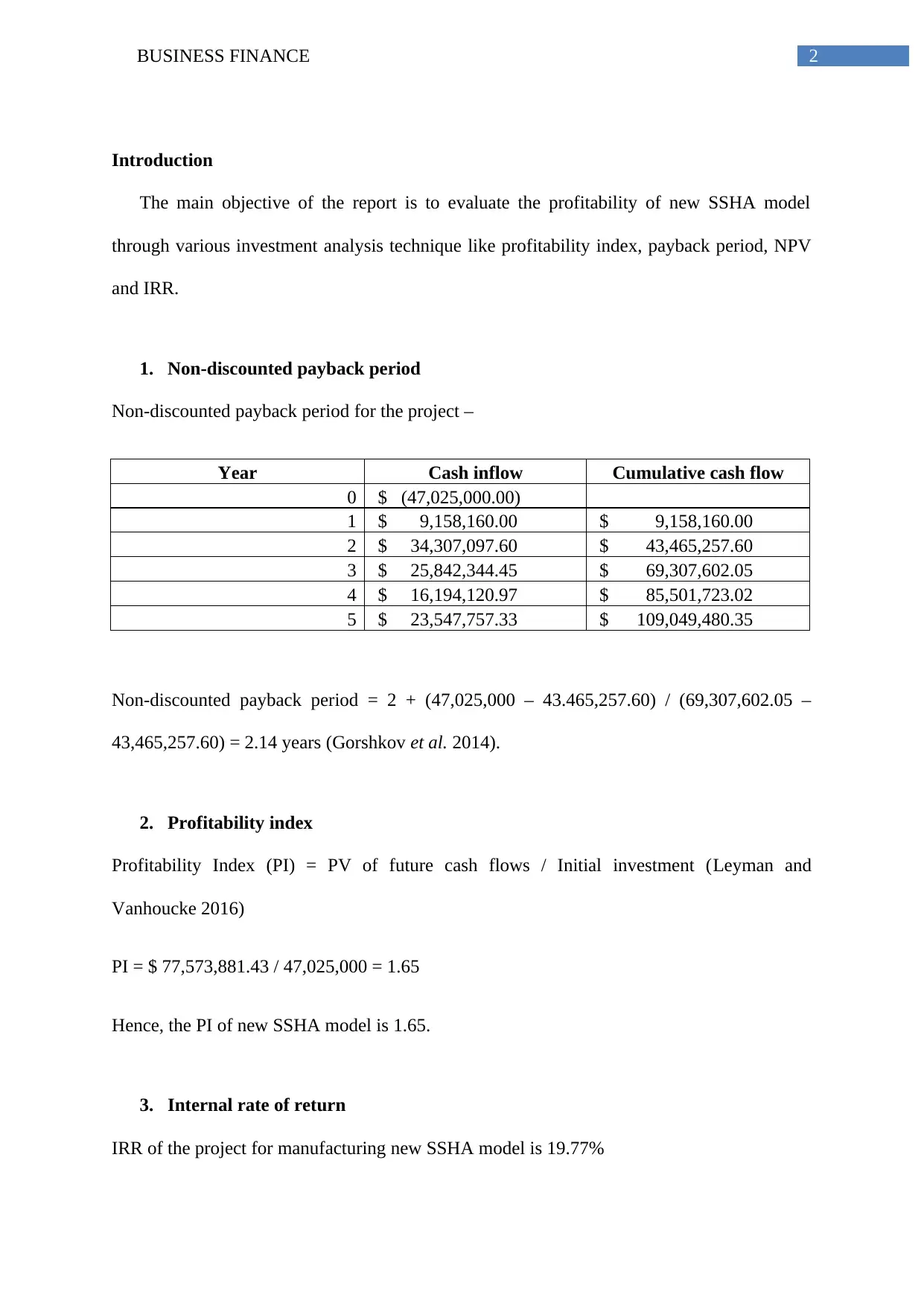
2BUSINESS FINANCE
Introduction
The main objective of the report is to evaluate the profitability of new SSHA model
through various investment analysis technique like profitability index, payback period, NPV
and IRR.
1. Non-discounted payback period
Non-discounted payback period for the project –
Year Cash inflow Cumulative cash flow
0 $ (47,025,000.00)
1 $ 9,158,160.00 $ 9,158,160.00
2 $ 34,307,097.60 $ 43,465,257.60
3 $ 25,842,344.45 $ 69,307,602.05
4 $ 16,194,120.97 $ 85,501,723.02
5 $ 23,547,757.33 $ 109,049,480.35
Non-discounted payback period = 2 + (47,025,000 – 43.465,257.60) / (69,307,602.05 –
43,465,257.60) = 2.14 years (Gorshkov et al. 2014).
2. Profitability index
Profitability Index (PI) = PV of future cash flows / Initial investment (Leyman and
Vanhoucke 2016)
PI = $ 77,573,881.43 / 47,025,000 = 1.65
Hence, the PI of new SSHA model is 1.65.
3. Internal rate of return
IRR of the project for manufacturing new SSHA model is 19.77%
Introduction
The main objective of the report is to evaluate the profitability of new SSHA model
through various investment analysis technique like profitability index, payback period, NPV
and IRR.
1. Non-discounted payback period
Non-discounted payback period for the project –
Year Cash inflow Cumulative cash flow
0 $ (47,025,000.00)
1 $ 9,158,160.00 $ 9,158,160.00
2 $ 34,307,097.60 $ 43,465,257.60
3 $ 25,842,344.45 $ 69,307,602.05
4 $ 16,194,120.97 $ 85,501,723.02
5 $ 23,547,757.33 $ 109,049,480.35
Non-discounted payback period = 2 + (47,025,000 – 43.465,257.60) / (69,307,602.05 –
43,465,257.60) = 2.14 years (Gorshkov et al. 2014).
2. Profitability index
Profitability Index (PI) = PV of future cash flows / Initial investment (Leyman and
Vanhoucke 2016)
PI = $ 77,573,881.43 / 47,025,000 = 1.65
Hence, the PI of new SSHA model is 1.65.
3. Internal rate of return
IRR of the project for manufacturing new SSHA model is 19.77%
⊘ This is a preview!⊘
Do you want full access?
Subscribe today to unlock all pages.

Trusted by 1+ million students worldwide
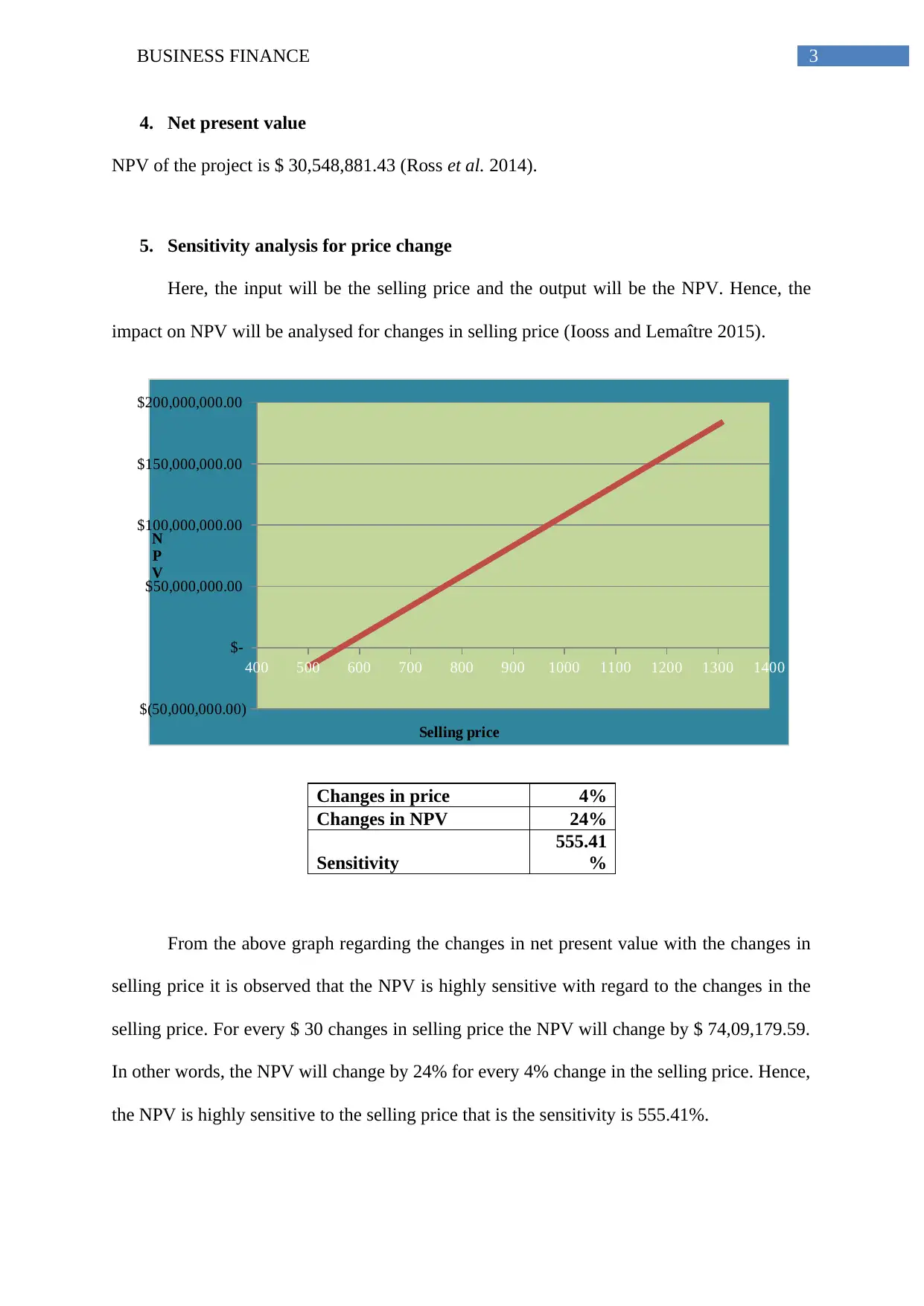
3BUSINESS FINANCE
4. Net present value
NPV of the project is $ 30,548,881.43 (Ross et al. 2014).
5. Sensitivity analysis for price change
Here, the input will be the selling price and the output will be the NPV. Hence, the
impact on NPV will be analysed for changes in selling price (Iooss and Lemaître 2015).
400 500 600 700 800 900 1000 1100 1200 1300 1400
$(50,000,000.00)
$-
$50,000,000.00
$100,000,000.00
$150,000,000.00
$200,000,000.00
Selling price
N
P
V
Changes in price 4%
Changes in NPV 24%
Sensitivity
555.41
%
From the above graph regarding the changes in net present value with the changes in
selling price it is observed that the NPV is highly sensitive with regard to the changes in the
selling price. For every $ 30 changes in selling price the NPV will change by $ 74,09,179.59.
In other words, the NPV will change by 24% for every 4% change in the selling price. Hence,
the NPV is highly sensitive to the selling price that is the sensitivity is 555.41%.
4. Net present value
NPV of the project is $ 30,548,881.43 (Ross et al. 2014).
5. Sensitivity analysis for price change
Here, the input will be the selling price and the output will be the NPV. Hence, the
impact on NPV will be analysed for changes in selling price (Iooss and Lemaître 2015).
400 500 600 700 800 900 1000 1100 1200 1300 1400
$(50,000,000.00)
$-
$50,000,000.00
$100,000,000.00
$150,000,000.00
$200,000,000.00
Selling price
N
P
V
Changes in price 4%
Changes in NPV 24%
Sensitivity
555.41
%
From the above graph regarding the changes in net present value with the changes in
selling price it is observed that the NPV is highly sensitive with regard to the changes in the
selling price. For every $ 30 changes in selling price the NPV will change by $ 74,09,179.59.
In other words, the NPV will change by 24% for every 4% change in the selling price. Hence,
the NPV is highly sensitive to the selling price that is the sensitivity is 555.41%.
Paraphrase This Document
Need a fresh take? Get an instant paraphrase of this document with our AI Paraphraser
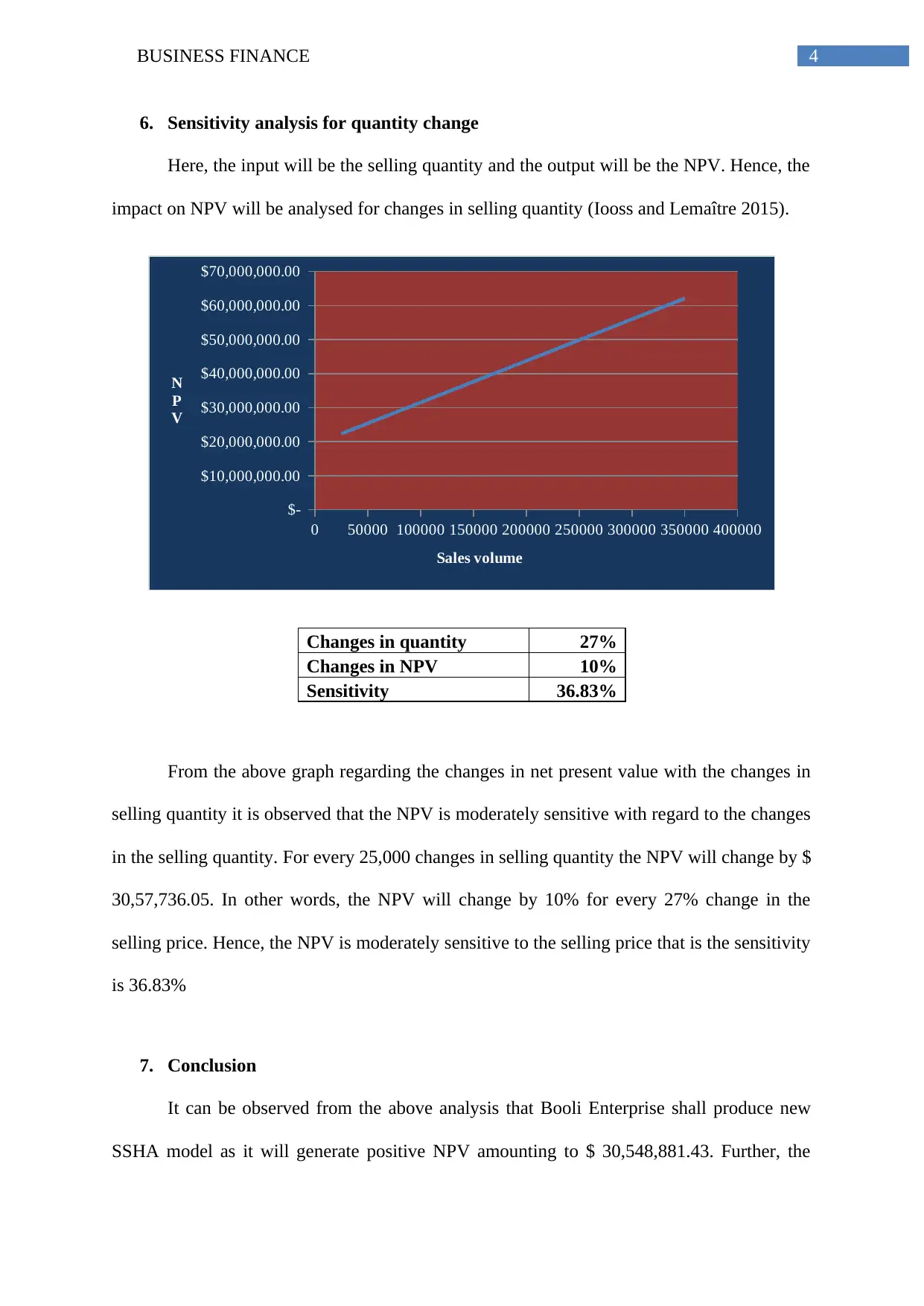
4BUSINESS FINANCE
6. Sensitivity analysis for quantity change
Here, the input will be the selling quantity and the output will be the NPV. Hence, the
impact on NPV will be analysed for changes in selling quantity (Iooss and Lemaître 2015).
0 50000 100000 150000 200000 250000 300000 350000 400000
$-
$10,000,000.00
$20,000,000.00
$30,000,000.00
$40,000,000.00
$50,000,000.00
$60,000,000.00
$70,000,000.00
Sales volume
N
P
V
Changes in quantity 27%
Changes in NPV 10%
Sensitivity 36.83%
From the above graph regarding the changes in net present value with the changes in
selling quantity it is observed that the NPV is moderately sensitive with regard to the changes
in the selling quantity. For every 25,000 changes in selling quantity the NPV will change by $
30,57,736.05. In other words, the NPV will change by 10% for every 27% change in the
selling price. Hence, the NPV is moderately sensitive to the selling price that is the sensitivity
is 36.83%
7. Conclusion
It can be observed from the above analysis that Booli Enterprise shall produce new
SSHA model as it will generate positive NPV amounting to $ 30,548,881.43. Further, the
6. Sensitivity analysis for quantity change
Here, the input will be the selling quantity and the output will be the NPV. Hence, the
impact on NPV will be analysed for changes in selling quantity (Iooss and Lemaître 2015).
0 50000 100000 150000 200000 250000 300000 350000 400000
$-
$10,000,000.00
$20,000,000.00
$30,000,000.00
$40,000,000.00
$50,000,000.00
$60,000,000.00
$70,000,000.00
Sales volume
N
P
V
Changes in quantity 27%
Changes in NPV 10%
Sensitivity 36.83%
From the above graph regarding the changes in net present value with the changes in
selling quantity it is observed that the NPV is moderately sensitive with regard to the changes
in the selling quantity. For every 25,000 changes in selling quantity the NPV will change by $
30,57,736.05. In other words, the NPV will change by 10% for every 27% change in the
selling price. Hence, the NPV is moderately sensitive to the selling price that is the sensitivity
is 36.83%
7. Conclusion
It can be observed from the above analysis that Booli Enterprise shall produce new
SSHA model as it will generate positive NPV amounting to $ 30,548,881.43. Further, the
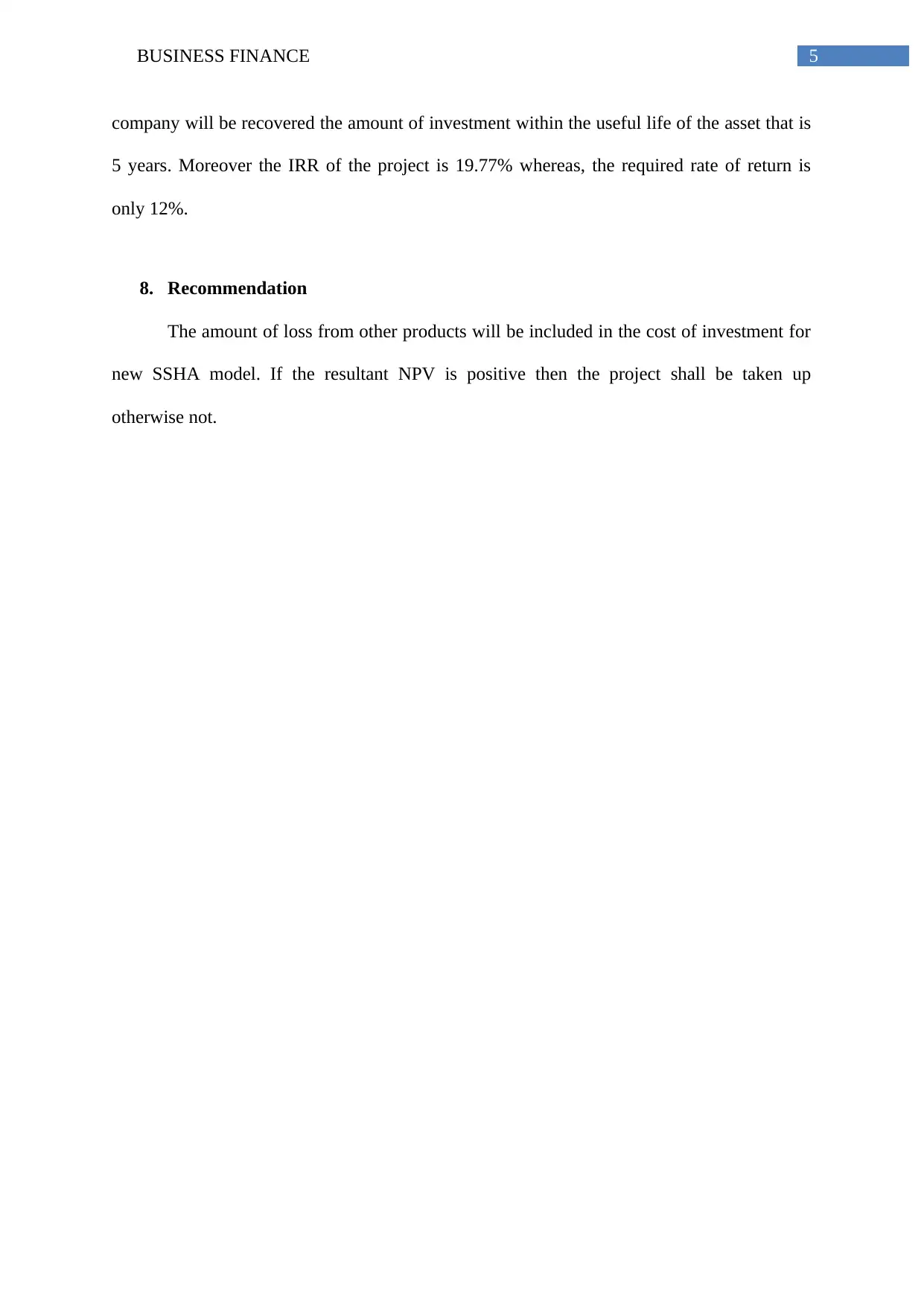
5BUSINESS FINANCE
company will be recovered the amount of investment within the useful life of the asset that is
5 years. Moreover the IRR of the project is 19.77% whereas, the required rate of return is
only 12%.
8. Recommendation
The amount of loss from other products will be included in the cost of investment for
new SSHA model. If the resultant NPV is positive then the project shall be taken up
otherwise not.
company will be recovered the amount of investment within the useful life of the asset that is
5 years. Moreover the IRR of the project is 19.77% whereas, the required rate of return is
only 12%.
8. Recommendation
The amount of loss from other products will be included in the cost of investment for
new SSHA model. If the resultant NPV is positive then the project shall be taken up
otherwise not.
⊘ This is a preview!⊘
Do you want full access?
Subscribe today to unlock all pages.

Trusted by 1+ million students worldwide
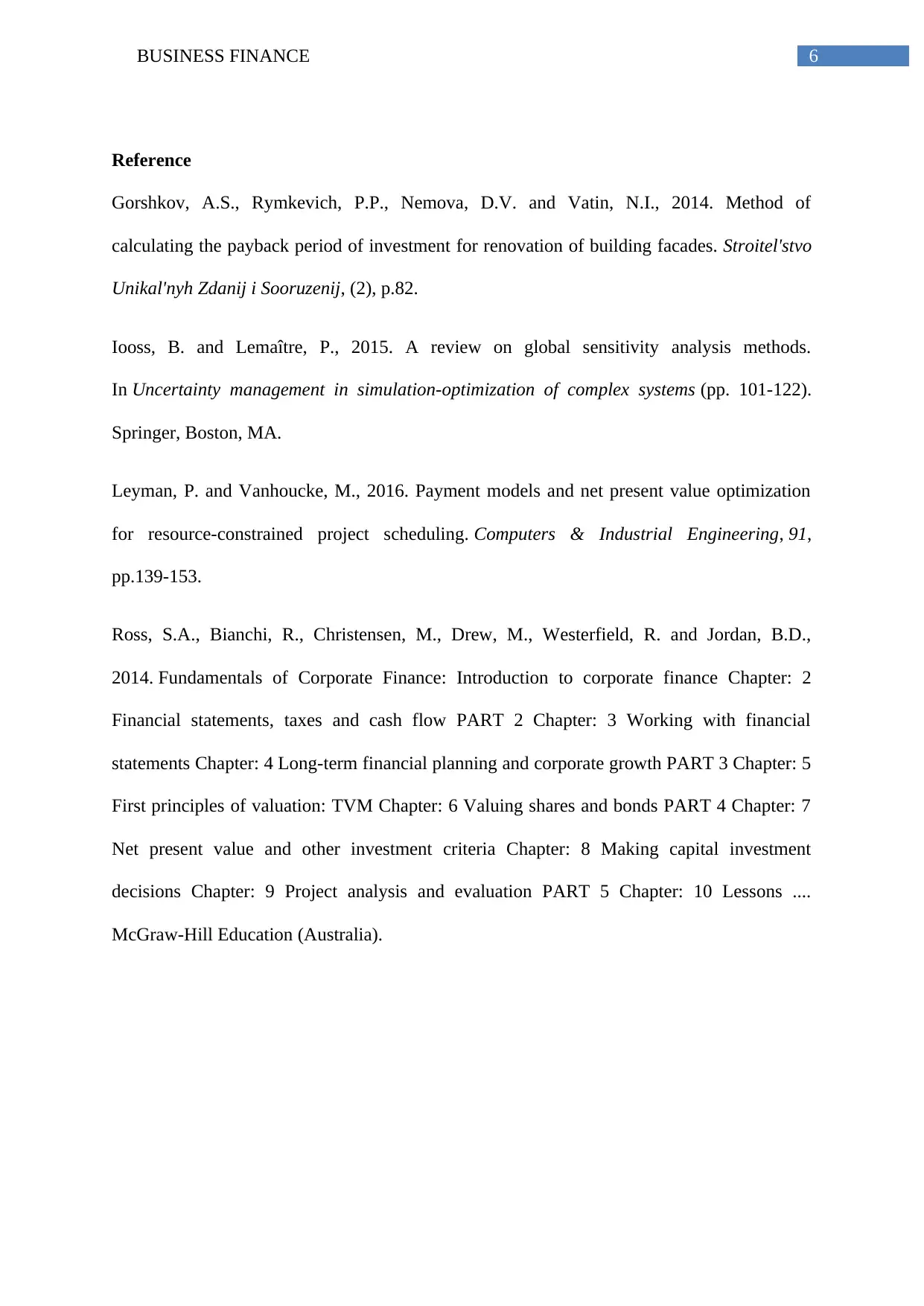
6BUSINESS FINANCE
Reference
Gorshkov, A.S., Rymkevich, P.P., Nemova, D.V. and Vatin, N.I., 2014. Method of
calculating the payback period of investment for renovation of building facades. Stroitel'stvo
Unikal'nyh Zdanij i Sooruzenij, (2), p.82.
Iooss, B. and Lemaître, P., 2015. A review on global sensitivity analysis methods.
In Uncertainty management in simulation-optimization of complex systems (pp. 101-122).
Springer, Boston, MA.
Leyman, P. and Vanhoucke, M., 2016. Payment models and net present value optimization
for resource-constrained project scheduling. Computers & Industrial Engineering, 91,
pp.139-153.
Ross, S.A., Bianchi, R., Christensen, M., Drew, M., Westerfield, R. and Jordan, B.D.,
2014. Fundamentals of Corporate Finance: Introduction to corporate finance Chapter: 2
Financial statements, taxes and cash flow PART 2 Chapter: 3 Working with financial
statements Chapter: 4 Long-term financial planning and corporate growth PART 3 Chapter: 5
First principles of valuation: TVM Chapter: 6 Valuing shares and bonds PART 4 Chapter: 7
Net present value and other investment criteria Chapter: 8 Making capital investment
decisions Chapter: 9 Project analysis and evaluation PART 5 Chapter: 10 Lessons ....
McGraw-Hill Education (Australia).
Reference
Gorshkov, A.S., Rymkevich, P.P., Nemova, D.V. and Vatin, N.I., 2014. Method of
calculating the payback period of investment for renovation of building facades. Stroitel'stvo
Unikal'nyh Zdanij i Sooruzenij, (2), p.82.
Iooss, B. and Lemaître, P., 2015. A review on global sensitivity analysis methods.
In Uncertainty management in simulation-optimization of complex systems (pp. 101-122).
Springer, Boston, MA.
Leyman, P. and Vanhoucke, M., 2016. Payment models and net present value optimization
for resource-constrained project scheduling. Computers & Industrial Engineering, 91,
pp.139-153.
Ross, S.A., Bianchi, R., Christensen, M., Drew, M., Westerfield, R. and Jordan, B.D.,
2014. Fundamentals of Corporate Finance: Introduction to corporate finance Chapter: 2
Financial statements, taxes and cash flow PART 2 Chapter: 3 Working with financial
statements Chapter: 4 Long-term financial planning and corporate growth PART 3 Chapter: 5
First principles of valuation: TVM Chapter: 6 Valuing shares and bonds PART 4 Chapter: 7
Net present value and other investment criteria Chapter: 8 Making capital investment
decisions Chapter: 9 Project analysis and evaluation PART 5 Chapter: 10 Lessons ....
McGraw-Hill Education (Australia).
1 out of 7
Related Documents
Your All-in-One AI-Powered Toolkit for Academic Success.
+13062052269
info@desklib.com
Available 24*7 on WhatsApp / Email
![[object Object]](/_next/static/media/star-bottom.7253800d.svg)
Unlock your academic potential
Copyright © 2020–2025 A2Z Services. All Rights Reserved. Developed and managed by ZUCOL.





